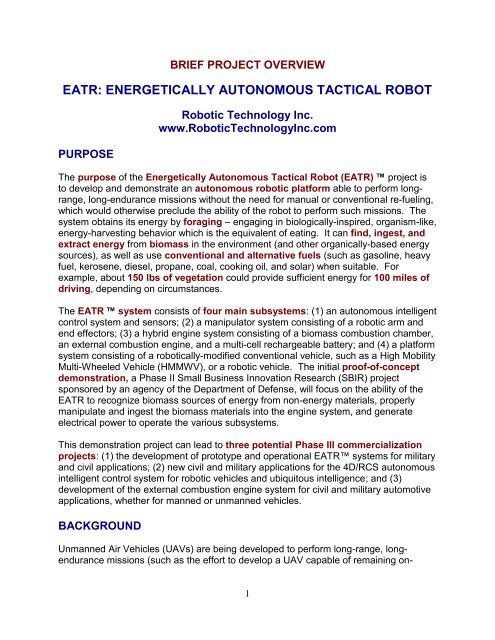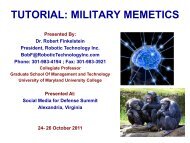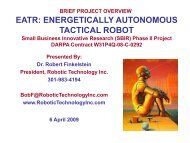eatr: energetically autonomous tactical robot - Robotic Technology Inc.
eatr: energetically autonomous tactical robot - Robotic Technology Inc.
eatr: energetically autonomous tactical robot - Robotic Technology Inc.
You also want an ePaper? Increase the reach of your titles
YUMPU automatically turns print PDFs into web optimized ePapers that Google loves.
BRIEF PROJECT OVERVIEW<br />
EATR: ENERGETICALLY AUTONOMOUS TACTICAL ROBOT<br />
PURPOSE<br />
<strong>Robotic</strong> <strong>Technology</strong> <strong>Inc</strong>.<br />
www.<strong>Robotic</strong><strong>Technology</strong><strong>Inc</strong>.com<br />
The purpose of the Energetically Autonomous Tactical Robot (EATR) project is<br />
to develop and demonstrate an <strong>autonomous</strong> <strong>robot</strong>ic platform able to perform longrange,<br />
long-endurance missions without the need for manual or conventional re-fueling,<br />
which would otherwise preclude the ability of the <strong>robot</strong> to perform such missions. The<br />
system obtains its energy by foraging – engaging in biologically-inspired, organism-like,<br />
energy-harvesting behavior which is the equivalent of eating. It can find, ingest, and<br />
extract energy from biomass in the environment (and other organically-based energy<br />
sources), as well as use conventional and alternative fuels (such as gasoline, heavy<br />
fuel, kerosene, diesel, propane, coal, cooking oil, and solar) when suitable. For<br />
example, about 150 lbs of vegetation could provide sufficient energy for 100 miles of<br />
driving, depending on circumstances.<br />
The EATR system consists of four main subsystems: (1) an <strong>autonomous</strong> intelligent<br />
control system and sensors; (2) a manipulator system consisting of a <strong>robot</strong>ic arm and<br />
end effectors; (3) a hybrid engine system consisting of a biomass combustion chamber,<br />
an external combustion engine, and a multi-cell rechargeable battery; and (4) a platform<br />
system consisting of a <strong>robot</strong>ically-modified conventional vehicle, such as a High Mobility<br />
Multi-Wheeled Vehicle (HMMWV), or a <strong>robot</strong>ic vehicle. The initial proof-of-concept<br />
demonstration, a Phase II Small Business Innovation Research (SBIR) project<br />
sponsored by an agency of the Department of Defense, will focus on the ability of the<br />
EATR to recognize biomass sources of energy from non-energy materials, properly<br />
manipulate and ingest the biomass materials into the engine system, and generate<br />
electrical power to operate the various subsystems.<br />
This demonstration project can lead to three potential Phase III commercialization<br />
projects: (1) the development of prototype and operational EATR systems for military<br />
and civil applications; (2) new civil and military applications for the 4D/RCS <strong>autonomous</strong><br />
intelligent control system for <strong>robot</strong>ic vehicles and ubiquitous intelligence; and (3)<br />
development of the external combustion engine system for civil and military automotive<br />
applications, whether for manned or unmanned vehicles.<br />
BACKGROUND<br />
Unmanned Air Vehicles (UAVs) are being developed to perform long-range, longendurance<br />
missions (such as the effort to develop a UAV capable of remaining on-<br />
1
station uninterrupted for over five years to perform intelligence, surveillance,<br />
reconnaissance (ISR), and communication missions over an area of interest). Likewise,<br />
there is a need for Unmanned Ground Vehicles (UGVs) to perform long-range, longendurance<br />
missions without manual or conventional refueling (however, unlike for<br />
UAVs, solar energy alone is insufficient for most UGV energy requirements).<br />
A <strong>robot</strong>ic vehicle’s inherent advantage is its ability to engage in long-endurance,<br />
tedious, and hazardous tasks, such as Reconnaissance, Surveillance, and Target<br />
Acquisition (RSTA) under difficult conditions, without fatigue or stress. This advantage<br />
can be severely reduced by the need for the <strong>robot</strong>ic platform to replenish its fuel supply.<br />
Example long-range, long-endurance missions for <strong>robot</strong>ic ground vehicles include:<br />
RSTA missions in the mountains and caves of Afghanistan and Pakistan; search<br />
missions for nuclear facilities and underground bunkers in rogue nations; special<br />
operations and counter-insurgency; patrolling remote borders; homeland security;<br />
serving as nodes in distributed and remote command, control, communications, and<br />
intelligence (C3I) networks; and serving as remote, mobile sensor and target tracking<br />
platforms in ballistic missile defense systems. Either strategically or <strong>tactical</strong>ly, longrange,<br />
long-endurance UGVs can work cooperatively with – and complement –<br />
long-range, long-endurance UAVs.<br />
TECHNICAL OBJECTIVES<br />
The initial objective is to develop and demonstrate a proof-of-concept system.<br />
Demonstration of a full operational prototype is the objective for a Phase III<br />
commercialization project.<br />
The project will demonstrate the ability of the EATR to: (1) identify suitable biomass<br />
sources of energy and distinguish those sources from unsuitable materials (e.g., wood,<br />
grass, or paper from rocks, metal, or glass); (2) spatially locate and manipulate the<br />
sources of energy (e.g., cut or shred to size, grasp, lift, and ingest); and (3) convert the<br />
biomass to sufficient electrical energy to power the EATR subsystems.<br />
The EATR system has four major subsystems: a <strong>robot</strong>ic mobility platform<br />
subsystem; an <strong>autonomous</strong>, intelligent control and sensor subsystem; a <strong>robot</strong>ic arm and<br />
end effectors subsystem; and a hybrid external combustion engine subsystem.<br />
<strong>Robotic</strong> Mobility Platform<br />
The <strong>autonomous</strong> <strong>robot</strong>ic mobility platform may consist of any suitable automotive<br />
vehicle, such as a <strong>robot</strong>ically-modified High Mobility Multi-Wheeled Vehicle (HMMWV),<br />
or a purely <strong>robot</strong>ic vehicle. The platform provides mobility for the mission and mission<br />
payload, and, for our proof-of-concept purposes, accommodation for the EATR<br />
subsystems.<br />
2
The <strong>robot</strong>ic mobility platform is not the focus of this project, nor is it essential for the<br />
EATR proof-of-concept demonstration. However, it will be included to provide a more<br />
realistic system context than a laboratory “breadboard” type demonstration of the<br />
EATR subsystems. The vehicle may, in fact, be either an <strong>autonomous</strong> or tele<strong>robot</strong>ic<br />
HMMWV, although its movement (including cross-country path planning and obstacle<br />
avoidance) will be an optional part of the proof-of-concept demonstration. The<br />
subsystems, for example, might be mounted on a trailer attached to the vehicle. We are<br />
also examining an all-electric vehicle to serve as the mobility platform for the<br />
demonstration.<br />
Autonomous Intelligent Control<br />
The <strong>autonomous</strong> intelligent control subsystem will consist of the 4D/RCS (three<br />
dimensions of space, one dimension of time, Real-time Control System) architecture,<br />
with new software modules which we will create for the EATR. The 4D/RCS has<br />
been under development by the Intelligent Systems Division of the National Institute of<br />
Standards and <strong>Technology</strong> (NIST), an agency of the U.S. Department of Commerce, for<br />
more than three decades with an investment exceeding $125 million. The NIST<br />
4D/RCS has been demonstrated successfully in various <strong>autonomous</strong> intelligent<br />
vehicles, and a variation of the 4D/RCS serves as the Autonomous Navigation System<br />
(ANS) mandated for all <strong>robot</strong>ic vehicles in the Army’s Future Combat System (an<br />
additional investment of $250 million). NIST is providing assistance in transferring the<br />
4D/RCS technology for the EATR.<br />
The control subsystem will also include the sensors needed for the demonstration (e.g.,<br />
optical, ladar, infrared, and acoustic). While the NIST 4D/RCS architecture is capable<br />
of <strong>autonomous</strong> vehicle mobility, it will be used in this project to: control the movement<br />
and operation of the sensors, process sensor data to provide situational awareness<br />
such that the EATR is able to identify and locate suitable biomass for energy<br />
production; control the movement and operation of the <strong>robot</strong>ic arm and end effector to<br />
manipulate the biomass and ingest it into the combustion chamber; and control the<br />
operation of the hybrid engine to provide suitable power for the required functions.<br />
The 4D/RCS is a framework in which sensors, sensor processing, databases,<br />
computer models, and machine controls may be linked and operated such that the<br />
system behaves as if it were intelligent. It can provide a system with several types of<br />
intelligence (where intelligence is the ability to make an appropriate choice or<br />
decision):<br />
(1) Reactive intelligence based on an autonomic sense-act modality which is the<br />
ability of the system to make an appropriate choice in response to an immediate<br />
environmental stimulus (i.e., a threat or opportunity). Example: the vehicle moves<br />
toward a vegetation sensed by optical image processing.<br />
(2) Deliberative intelligence, which includes prediction and learning, which is based<br />
on world models, memory, planning, and task decomposition, and includes the ability to<br />
3
make appropriate choices for events that have not yet occurred but which are based on<br />
prior events. Example: the vehicle moves downhill in a dry area to search for wetter<br />
terrain which would increase the probability of finding biomass for energy.<br />
(3) Creative intelligence, which is based on learning and the ability to cognitively<br />
model and simulate and it is the ability to make appropriate choices about events<br />
which have not yet been experienced. Example: from a chance encounter with a<br />
dumpster, the vehicle learns that such entities are repositories of paper, cardboard, and<br />
other combustible materials, and develops tactics to exploit them as energy-rich<br />
sources of fuel.<br />
<strong>Robotic</strong> Arm and End Effector<br />
The <strong>robot</strong>ic arm and end effector will be attached to the <strong>robot</strong>ic mobility platform,<br />
either directly or affixed to a platform towed behind the HMMWV. It will have sufficient<br />
degrees-of-freedom, extend sufficiently from the platform, and have a sufficient payload<br />
to reach and lift appropriate materials in its vicinity. The end effector will consist of a<br />
multi-fingered (e.g., three-fingered or two-thumb, one-finger) hand with sufficient<br />
degrees-of-freedom to grasp and operate a cutting tool (e.g., a circular saw) to<br />
demonstrate an ability to prepare biomass for ingestion, and to grasp and manipulate<br />
biomass for ingestion.<br />
Hybrid External Combustion Engine<br />
The source of power for EATR: new hybrid external combustion engine system<br />
from Cyclone Power <strong>Technology</strong> <strong>Inc</strong>. It is integrated with a biomass combustion<br />
chamber to provide heat energy for the engine (EATR can also carry supplemental fuel,<br />
such as propane). The engine will provide electric current for a rechargeable battery<br />
pack, which will power the sensors, processors and controls, and the <strong>robot</strong>ic arm/end<br />
effector (a rechargeable battery pack ensures continuous energy output despite<br />
intermittent biomass energy intake). The hybrid external combustion engine is very<br />
quiet, reliable, efficient, and fuel-flexible compared with the internal combustion engine.<br />
The engine will not provide mobility power for vehicle for the proof-of-concept, but it will<br />
for the EATR prototype<br />
COMMERCIALIZATION<br />
Our vision is that this demonstration project will lead to three potential Phase III<br />
commercialization projects: (1) the development of prototype and operational<br />
EATR systems for military and civil applications; (2) new civil and military applications<br />
for the <strong>autonomous</strong> intelligent control system; and (3) development of the Stirling engine<br />
system for civil and military automotive applications, whether for manned or unmanned<br />
vehicles.<br />
4
EATR<br />
In Phase III, EATR will be commercialized for long-range, long-endurance military<br />
missions, but it also has civil applications as well – wherever vehicles must function<br />
in wilderness areas for extended periods of time, such as for forestry, exploration,<br />
natural resource monitoring, fire protection, and border patrol. Agriculture, for example,<br />
is a particularly promising application, where energy-intensive vehicles such as tractors<br />
and harvesters could glean their energy directly from waste biomass in the field.<br />
AUTONOMOUS INTELLIGENT CONTROL: 4D/RCS<br />
The Phase III commercialization of the 4D/RCS <strong>autonomous</strong> intelligent control system<br />
promises to be the most significant opportunity. In addition to its potential for<br />
achieving a high level of performance – and ultimately cognition – in various kinds of<br />
<strong>robot</strong>s, it will serve as the basis for ubiquitous intelligence: the ability to insert<br />
intelligence into entities and facilities of all kinds. With sensors and voice interaction,<br />
we will be able to converse with our walls without having lost our sanity.<br />
The 4D/RCS can serve as the basis as a decision tool for managing complex systems<br />
of systems, whether for the military (as for the Future Combat System (FCS) where it<br />
could provide an overarching decision framework for ground and air <strong>robot</strong>ic and<br />
manned platforms, or civil applications such as for traffic control or management of<br />
large organizations. In a corporation, for example, historical and real-time data can flow<br />
into the system concerning sales, competition, investors, geopolitics, environmental<br />
conditions, etc. (instead of data from sensors for <strong>robot</strong>ic control) and the processed data<br />
can flow through the world model and task decomposition modules to provide<br />
suggested courses of action to decision makers (or be allowed to act <strong>autonomous</strong>ly for<br />
some decisions). Large interactive displays can show the system’s real-time interaction<br />
embodying the corporation’s classic SWOT analysis: Strengths, Opportunities,<br />
Weaknesses, and Threats.<br />
HYBRID EXTERNAL COMBUSTION ENGINE<br />
Unlike internal combustion engines, the Cyclone engine, which is a type of Rankine<br />
cycle steam engine, uses an external combustion chamber to heat a separate<br />
working fluid (de-ionized water) which expands to create mechanical energy by moving<br />
pistons or a turbine. Combustion is external so the engine is extremely fuel-flexible and<br />
can run on any fuel (solid, liquid, or gaseous), including: biomass, agricultural waste,<br />
coal, municipal trash, kerosene, ethanol, diesel, gasoline, heavy fuel, chicken fat, palm<br />
oil, cottonseed oil, algae oil, hydrogen, propane, etc. – individually or in combination. A<br />
100 Hp prototype engine for vehicles has been developed.<br />
The Cyclone engine is environmentally friendly because combustion is continuous<br />
and more easily regulated for temperature, oxidizers, and fuel amount. Lower<br />
combustion temperatures and pressures create less toxic and exotic exhaust gases. A<br />
uniquely configured combustion chamber creates a rotating flow that facilitates<br />
5
complete air and fuel mixing, and complete combustion, so there are virtually no<br />
emissions. Less waste heat is released (hundreds of degrees lower than internal<br />
combustion exhaust). The engine does not need: a catalytic converter, radiator,<br />
transmission, oil pump or lubricating oil (because it is water lubricated). The decreased<br />
engine size and weight provides increased efficiency and reliability.<br />
6





